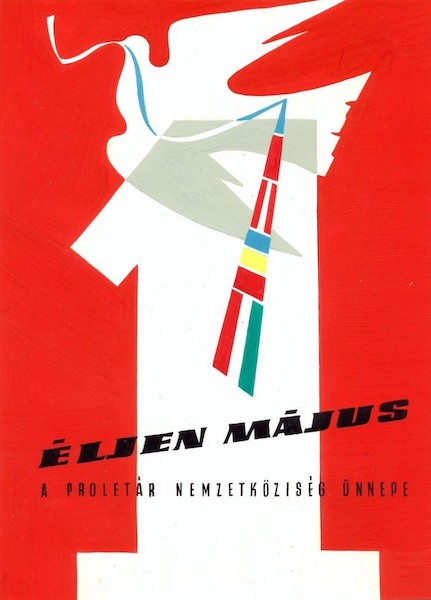
Description:
Interesting, painted poster artwork, created by Bertalan Altmann in 1957, for the socialist celebration of the 1st of May. It is the May Day or labour day even today, but for some years during the Socialist era in Hungary it was also the celebration of proletarian internationalism.
A new period started in Hungarian poster art after the 1956 revolution. The former Rákosi-regime was replaced by the Kádár-system, and the new political situation determined the cultural changes as well. The former great expansion of political propaganda posters of the 1950s came to an end as the new political leadership realized that political issues should be avoided on streets. Along with political propaganda posters commercial posters also disappeared for a while due to the lack of products and independent clients. On the other hand, the genre of cultural poster had its heyday in the 1960s and 1970s.
Although political matters could not appear on posters of the time, there was an exception: big annual political events, state celebrations and anniversaries. These events could fit in the range of cultural events and posters of them also could function as cultural posters. These annual events generated a separated type of cultural poster design and they also gave a hard task to poster designers. The topic was the same year by year and the iconography had its own recurrent elements: waving flags, emblematic state buildings and political symbols appeared in these posters. It didn’t belong to the fancied duty of poster artists neither, but it was a help in case of a constraint of financial matters.
Compared to the average number of copies of a poster (which was about 400-4000) these posters had a high number of copies, about 10-30 000. The size of the poster was bigger than average and the quality and thickness of the paper used was also better. So this genre was a special type from several aspects.
This poster artwork is a quite modernist design compared to the fact that the political leadership of the period was fighting against all kinds of modernist visuality. The poster artwork was created one year after the end of the absolutism of Socialist Realism in Hungary. The style was the compulsory aesthetic norm of the Rákosi-era, but still after 1956, and with the change of the political situation too, the aesthetic views of the current political power of Hungary didn’t really change. A new system was initialized in cultural politcs: all kinds of designs were put into three categories: „prohibited”, „tolerated” or „promoted”. Thus new styles could emerge, but the old aesthetic views could be propagated easily.
The posters of annual celebrations could sometimes be exceptions as we can find some examples of them with a more abstract design. This poster artwork is a decoratively modern piece with a big white number of 1 in the centre, a white figure of a pigeon, holding a ribbon in its beak, and a line of flags of countries from the former Eastern bloc. The background is coloured by the symbolic left-wing red. The composition is modern and concentrated with the few colours, elements and shapes used. The visual effect of the different shades used where elements cross contributes to the decorativeness of the design as well. The pigeon is a universal symbol of peace, the flags of Eastern bloc-countries represent the proletarian internationalism, celebrated on the 1st of May.
The use of symbolic elements together with political content makes the poster artwork an obvious propaganda work, but compared to the numerous ones of the former Rákosi-era with the forced socialist realist typical compositions and portrays of political leaders, this work is a good example of a skillful and strong visual design. Due to the fact that it was created for the socialist celebration of the 1st of May, the final poster could function as a cultural poster in the first place. Created one year after the revolution of 1956, this piece is also a special relic from the time of changes in Hungary’s history.











